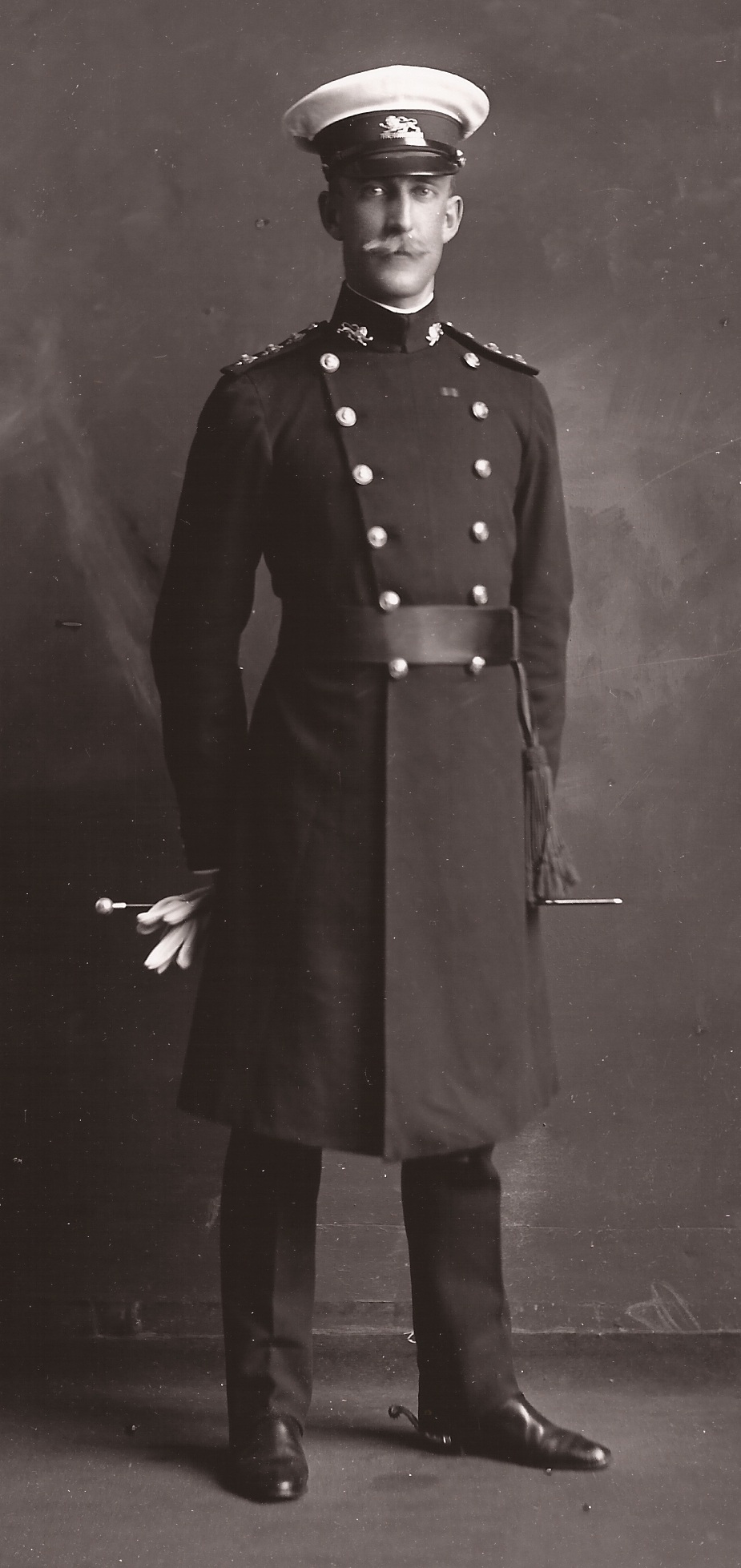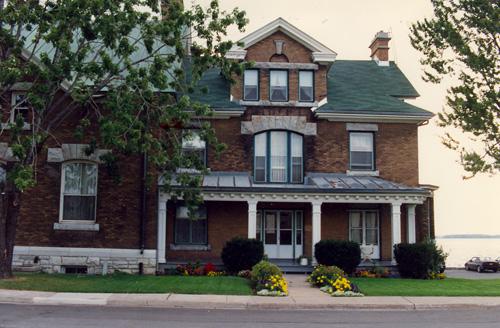LIEUT COLONEL HENRY ALBERT KAULBACK1 OBE
(Note that the spelling of the original family name of Kaulbach was anglicised by Deed Poll to Kaulback on 5 Jan 1922.)
Born: 16 Feb 1878 at Truro, Nova Scotia, Canada.
Elder (and only surviving) son of the Ven Archdeacon James Albert Kaulbach (sic) and Maria Sophia Bradshaw.
Died: 14 Nov 1929, at Swinbridge Muir, Dalry, Ayshire, the home of his friend Gen Walter Allason DSO.
| Educated: | Collegiate School, Windsor, Nova Scotia
Kings College, Windsor, Nova Scotia The Royal Military College, Kingston, Ontario (being awarded, on graduation in 1899, one of the two annual commissions from the RMC into the British Army). |
Married: 3 Apr 1907 at Southsea, England,
to Alice Mary Townend, of Dromderrig House, Kinsale, Co Cork, eldest daughter of Rev Alfred John Townend BA (Cantab) CF [Chaplain to the Forces], and Margaret Wiseman Stairs.
Army Career::
1899 Commissioned as Ensign, 2nd Battn 6th Regiment of Foot (Royal Warwickshire)
1899-1901 Served in the S African [Boer] War as a regimental subaltern, seeing frequent action. Wounded in the head, and Mentioned in Dispatches, at Battle of Diamond Hill, 11 Jun 1900.
1901-1904 Posted with his regiment to Bermuda to guard Boer POW's.
1904-1907 Posted to Portland, England, with his regiment.
1907-1908 Seconded as Superintendent of Gymnasia, Belfast, Ireland.
1907 (Nov) Transferred on promotion as Captain to 4th Regt of Foot (King's Own Royal Regiment)
1908-1911 Seconded as Staff Adjutant at the Royal Military College, Kingston, Ontario, Canada (see Postscript below).
1912-1914 Served as a company commander with 2nd Battn King's Own Royal Regiment in India (Naini Tal, Lucknow, Calcutta, Darjeeling, Lebong and Barrackpore).
1914 (Dec) Posted to Winchester with KORR, in newly-formed 28th Infantry Divn under Maj Gen Edward Bulfin.
1915 (Jan) Posted to Flanders with 83rd Brigade of 28th Infantry Divn, seeing action at Ypres in Battle of St Eloi. Division then moved north, encountering first deployment of gas by Germans and further fierce fighting.
1915 (20 Feb) Left arm shot away while leading attack on Hill 60. Repatriated for medical treatment.
1915 (Sep) Promoted to Major of KORR.
1916-1918 Appointed DAA [ Divisional? Adjutant] & QMG [Quartermaster General?] Northern Command, Catterick, Yorkshire.
1917 Promoted to Brevet Lieutenant Colonel KORR.
Mentioned in Dispatches for distinguished service.
1918 Mentioned in Dispatches for distinguished service.
1919 Appointed OBE.
1922-1924 Seconded as DAQMG [!!!] at GHQ Northern Command, York.
1924-1925 Rejoined 2nd Battn KORR as Second-in-Command at Rangoon, Burma.
1926 Posted with regiment to Rawalpindi, India.
1927 Promoted substantive Lieutenant Colonel to command 1st Battn KORR in 1st Infantry Divn at Aldershot, England.
1928 (28 May) Received by King George V (Colonel in Chief KORR) and Queen Mary to dinner (see Alice Townend/Random Recollections/Royal Dinner Party) at Royal Pavilion, Aldershot.
1929 (14 Nov) Died of lingering necrosis from amputation of left arm fourteen years earlier.
Recreations:
Athletics, Rugby football, boxing, mountain climbing, shooting, foxhunting, point-to-point racing.
References:
| 1: | The Kaulbacks, Lt Col R J A Kaulback DSO MA FRGS, published privately,1979 |
Postscript: Coming Full-Circle
In March 1982, my wife and I, together with our two young children, crossed the Atlantic for the first time (only narrowly avoiding the crash of Freddie Laker's cut-price Skytrain fiasco) to stay with her brother Peter and his family in Ottawa. Whilst there we were taken on a visit to the Royal Military College in Kingston, Ontario, and were given a tour of the publicly-accessible College buildings – an unprecedented glimpse into the military world for us. There were a great many historic photographs on display of bygone cadets and officers – amongst the latter being Harry Kaulback himself, still with both arms of course, generally on horseback as befitted his rank.
And outside again, perhaps the most unexpected sight of all was the Adjutant's House (aka Panet House / Maison Panet) in which Ronald and Bill had been born some seventy years previously! The following pictures and text can be seen on the website www.historicplaces.ca/en/rep-reg/place-lieu.aspx?id=11113.
Description of Historic Place
Royal Military College of Canada (RMC) Building 27, also known as Panet House, sits close to the water at the east side of the RMC campus. This two-storey residential structure, designed in the Classical Revival style, is clad in brick with stone and wooden details. The gable roof features a large front-facing, gabled dormer and three shed dormers to the rear. A broad and deep front porch contains the main entrance to the building. The designation is confined to the footprint of the building.
Heritage Value
RMC Building 27 is a Recognized Federal Heritage Building because of its historical associations, and its architectural and environmental value.
Historical Value
RMC Building 27 is associated with the theme of military officer training and the emergence of a professional armed force in Canada. The building is also associated with Major Raymond N.R. Reade, a British officer sent to the RMC from London in 1901, who authorized construction of a gymnasium, a hospital, an electrical plant, and a permanent accommodation for the staff-adjutant and his family. The first occupant of the permanent accommodation for staff-adjutant was the notable RMC graduate, Captain H.A. Panet. RMC Building 27 and the other constructions furthered by Reade were intended to improve both educational and program facilities at RMC, and recognized RMC as an institution that produced officers able to serve throughout the British Empire.
Architectural Value
RMC Building 27 is valued for its very good aesthetic design. Its design is influenced by the Classical Revival style, with details that make aesthetic connections with architectural precursors at the RMC itself, other defence establishments of the era and region, and contemporary domestic architecture in eastern Canada. The masonry and wooden details are evidence of its quality craftsmanship.





